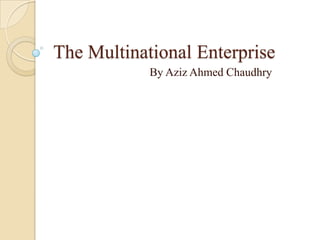The multinational enterprise
•Descargar como PPTX, PDF•
10 recomendaciones•15,274 vistas
Denunciar
Compartir
Denunciar
Compartir

Recomendados
Recomendados
Más contenido relacionado
La actualidad más candente
La actualidad más candente (20)
Advantages and disadvantages of INTERNATIONAL BUSINESS

Advantages and disadvantages of INTERNATIONAL BUSINESS
International Business Management unit 1 introduction

International Business Management unit 1 introduction
Destacado
Destacado (10)
Foreign trade policy india & its impact on indian trade

Foreign trade policy india & its impact on indian trade
Similar a The multinational enterprise
Similar a The multinational enterprise (20)
Entry Strategies - International Business - Manu Melwin Joy

Entry Strategies - International Business - Manu Melwin Joy
Entry strategies - corporate management - Strategic Management - Manu Melwin...

Entry strategies - corporate management - Strategic Management - Manu Melwin...
International Business Dynamics module 2 by Nagarjun Reddy

International Business Dynamics module 2 by Nagarjun Reddy
Unit-1-lecture-1(Introduction, Nature and Scope of International business)

Unit-1-lecture-1(Introduction, Nature and Scope of International business)
Market Entry Startegies of market ,How to improve your Brand awareness

Market Entry Startegies of market ,How to improve your Brand awareness
Más de kamran
Más de kamran (20)
The multinational enterprise
- 1. The Multinational Enterprise By Aziz Ahmed Chaudhry
- 2. Introduction A company headquartered in one country but having operations in one or more other countries. Example: Nestle the chocolate manufacturer is a Swiss company.
- 3. Characteristics of Multinational Enterprises Their affiliates must be responsive to a number of important environmental forces. It draws on a common pool of resources, including assets, patents, trademarks, information and human resources. It links together the affiliates and business partners with a common strategic vision.
- 4. The internationalization process It is a process by which a company enters a foreign market.
- 5. Major types of foreign entry Exporting and uses a local agent or distributor Export through own sales representative or sales subsidiary Local packaging and/or assembly Foreign direct investment
- 6. Why firms become multinational enterprises? A desire to protect themselves from the risks and uncertainties of the domestic business cycle A growing world market for their goods or services A response to increased foreign competition
- 7. Why firms become multinational enterprises? A desire to internalize in order to reduce costs A desire to overcome tariffs barriers And the chance to take advantage of technological expertise by manufacturing goods directly rather than allowing others to do it under a license agreement
- 8. The strategic philosophy of multinational enterprises It is different from that of home country businesses. MNEs do not see their company as an extension of its domestic roots. They hire, fire, and transfer personnel to meet global needs They also combine their talents with those of other MNEs in creating, financing and managing joint ventures.
- 9. The strategic management process Identification of the firm’s basic mission External and internal environmental analysis Formulation of objectives and overall plans Implementation of these plans Evaluation and control of operations
